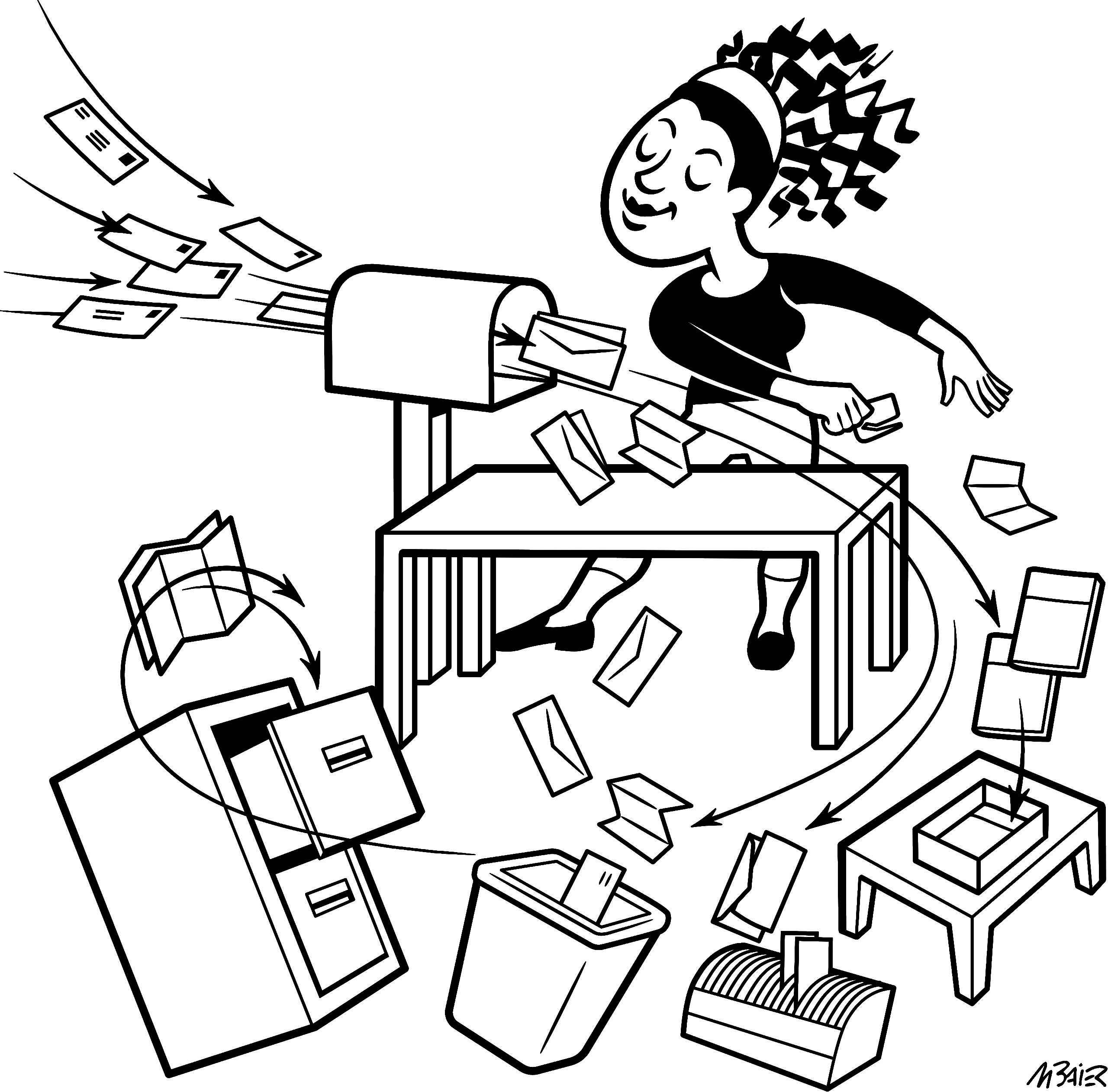What follows is an excerpt from my upcoming book “The Circulation Solution: The Ultimate Organizing Approach For Lasting Clutter Relief.” The focus of this chapter is on how to circulate the daily mail in a series of manageable, reliable steps.
Despite the option for electronic bill paying, and despite the new online advertising and online catalogs, we receive more paper mail than ever before. As a professional organizer I have witnessed unrelenting piles of it on kitchen counters, dining room tables, office desks, guest-room beds, and in make-it-go-away bags.
What are make-it-go-away bags? They are created when guests are coming and you clear all the junk on your dining room table into a bag and make it go away, often in a closet or an “all-purpose room” behind a closed door. It’s OK. You’ll get to the make-it-go-away bag later, you tell yourself.
We have a love/hate relationship with our mail. On the one hand, we hate how much of it is junk and we hate people asking us for money. On the other hand, we still hold out hope for that one percent that is a check, a personal letter, or a great opportunity.
There is no clutter that is more persistent than the daily mail. That’s a fact, but it is as vulnerable as all other forms of clutter when confronted with the circulation solution.
The Rule that Changes Everything
There are times, especially when we are crazy busy, that the daily onslaught of mail can seem like the enemy, but it is not the enemy because it doesn’t exist. Why? It comes down to one simple fact.
| “Mail stops being mail the second it comes out of the mailbox” |
How can I possibly say this? I can say this because mail is not the stuff that lands on your dining room table. Mail is the enveloped stuff between all the people trying to reach you and your mailbox. The items that come out of your mailbox are bills to pay, statements to file, periodicals to read, items to review, donations to consider, events to schedule, and a whole lot of junk to toss. There is no mail left.
Notice how I have attached each one of those items to an action. It is important to establish a clear distinction between the item and the action it requires. The first manageable, reliable stage in this circulation is to simply recognize which category each item falls into. What’s so important about recognizing this stage? It takes two minutes, not twenty. You could find two minutes every day, couldn’t you?
Just Sort
The idea here is not to worry about processing anything when you take those items from the mailbox. Just sort by category and do it FAST. It’s the classic divide and conquer strategy, but this needs to happen fast. Again, the more you believe that this stage takes just two minutes a day, the less likely you are to postpone it. Two minutes is manageable. Two minutes is reliable.
Sorting these items that come out of the mailbox is a process and, as you may recall from Chapter 2, there is a wonderful tool for processes. It is a clear work surface. This surface can be a kitchen counter or a dining room table, but the usage MUST be temporary.
I’m talking two-minutes temporary. Having the space to spread out and distinguish these items is important. The more space you have to act, the faster you can act. Once everything is sorted, you must have a manageable, reliable home for the next stages.
There should be a bill paying area. I happen to like the 31-day bill organizer. Others prefer a simple bill-paying folder. There should be a user-friendly filing system for statements to file, or at least a to-file tray. There should be an established reading zone. Maybe it’s a coffee table or a night table. In each case, these next stages need to be manageable and reliable too.
The one exception to allowing two stages (category and action) is the junk mail. In the same two minutes that you recognize junk mail, you should get rid of it. Don’t wait. Toss fast. If you are worried about recycling paper, be sure you have an easily accessible recycling transport bin. If you are worried about identity theft, you should have an easily accessible shredding bin. More on that later.
Focus on Finish
The most important goal with the daily stuff-that-comes-out-of-the-mailbox is to sort through it FAST. To achieve this, you need to remove ALL barriers. Often these barriers are hidden in the GOOD stuff, like letters and magazines. So my advice for the good stuff is simple:
| “Save Dessert for Last” |
Without a plan for getting through the mail, our brains naturally looks for what’s fun. Opening up a magazine or letter is fun. Eating a hot-fudge sundae is fun too, but you know it’s a better idea to enjoy it after a nutritious dinner. The same is true with a magazine or a letter.
With a plan for the mail, the nutritious dinner part doesn’t have to be a burden. You can get through the mail sort quickly, if you remove all the barriers. Fun mail can be one barrier and shredding can be another barrier.
Many of my clients who struggle with their mail proudly tell me about how they keep a shredder handy for all their junk mail. Shredding is important with the increase of identity theft, but it can also be a barrier if you are doing it before you sort your mail. Shredding is probably more enjoyable than dealing with the rest of the mail, so in that sense it is like dessert.
This is why I suggested sorting shred candidates into a shred bin earlier. Quickly get the sorting behind you, then shred away! If you then find you never get around to shredding the contents in the shred bin, then consider delegating the task to a family member or a shredding service. Anyone can shred, but only you can do the sorting.
***
So let’s review the keys to the Circulation Solution in the daily mail:
• Start with the right mindset. The second you take your mail out of the mailbox it is no longer mail but a few simple categories that require separate actions.
• Relieve yourself of the anxiety of acting upon this stuff from the mailbox and simply resolve to sort it. A simple sort is something that can and should be done FAST. That way it is not a burden to be avoided.
• Save dessert for last. The good stuff can be as much of a barrier as the actions. Get the sorting behind you. You can then reward yourself with dessert.
All of these approaches with the daily mail contribute to creating manageable, reliable stages, which facilitates movement and circulation. Of course the actions for these sorted items require next stages, but you can be rest assured that they will also be as manageable and as reliable. This will be the subject of our next chapter, Circulation in the Office.
UPDATE: The Circulation Solution: The Ultimate Approach For Lasting Clutter Relief ebook is available NOW for download at Amazon!
Please Share With Your Community
















